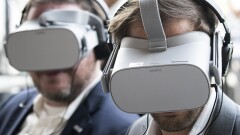As virtual reality and augmented reality devices become increasingly affordable and available to consumers, banks and payment companies have more opportunities to engage their customers in virtual worlds.
The efforts that financial services companies and retailers are making in VR and AR today are experimental, but make the most of a technology in its early phases. And as VR and AR mature, new possibilities open up for customer interaction in a virtual space.
This item is compiled from reporting by PaymentsSource writers including John Adams, Kate Fitzgerald, David Heun and Michael Moeser. Click the links in each item to read more.












